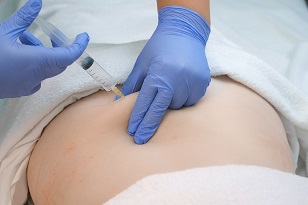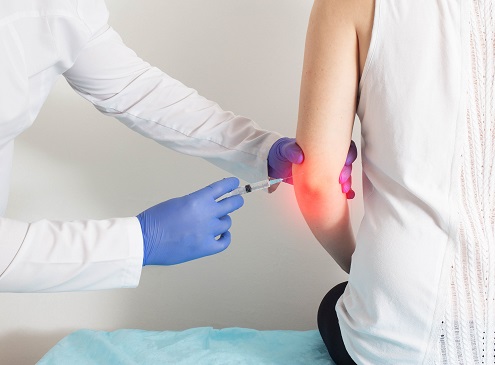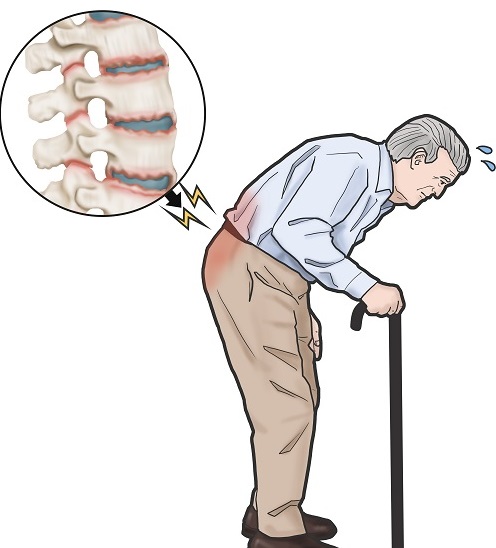It refers to drug injections applied in soft tissue diseases such as muscle, tendon, tendon sheath, entesis, ligament and bursa. These diseases are diseases that we encounter frequently in our daily practice and can be a cause of significant morbidity (disability). Local injection treatments are frequently applied in the treatment of these soft tissue pathologies. Corticosteroids and local anesthetic drugs are most commonly used in injection. Corticosteroids are used in most soft tissue pathologies to provide an inflammatory suppressing effect. Injections for the same area should not be repeated before 6 weeks and should not be administered more than 3-4 times a year.
Biceps Tendinitis Injection
Biceps tendon is the name given to the tendon of the muscle that makes the arm flexion (folding the arm) movement, which starts from the shoulder joint and extends towards the front of the elbow joint. Biceps tendinitis may occur in patients as a result of frequent shoulder-straining movements, recurrent traumas and sudden loads. It starts in the front of the shoulder and spreads down the front of the arm. Night pain may occur in patients. In the examination, biceps are painful by touching the tendon. Ultrasonography is an auxiliary imaging method in diagnosis. Cold application, anti-inflammatory drugs and physical therapy methods can be used in its treatment. Local soft tissue injection can be applied in patients who do not benefit from non-invasive treatment methods. Injections accompanied by USG imaging have a better chance of treatment.
Lateral Epicondite Injection
International epichondritis, also known as tennis elbow, is a painful condition caused by overuse of the elbow. Lateral epichonditis is a clinical picture characterized by inflammation (inflammation) in the places of adhesion of forearm muscles to the bone on the outer edge of the elbow. It is characterized by localized pain and tenderness on the outer side of the elbow. Pain can sometimes reflect on the shoulder or wrist area. Night pain may occur. In the examination, the lateral epichond is painful by touching. It can usually be easily diagnosed by physical examination. Ultrasonography is an auxiliary imaging method that can be used in diagnosis. Cold application, anti-inflammatory drugs, physical therapy methods and elbow splint can be used in the treatment. Local soft tissue injection can be applied in patients who do not benefit from non-invasive treatment methods
De QuervainTenosinovit Injection
It is a disease caused by the tendon lifting the thumb and the tendon that removes the thumb from the hand, and the tendons being trapped in the sheath they pass on the side. Knitting is a disease characterized by inflammation of the tendon and sheath structure that moves the thumb as a result of repetitive work such as using music instruments, gardening, baby care. Patients describe pain and tenderness alongside their wrists during difficult movements such as lifting something with their hands, clenching fists and carrying shopping bags. It can usually be easily diagnosed by physical examination. Ultrasonography is an auxiliary imaging method that can be used in diagnosis. Cold application, anti-inflammatory drugs, physical therapy methods and wrist splint can be used in the treatment. Local soft tissue injection can be applied in patients who do not benefit from non-invasive treatment methods.
Trigger Finger Injection
The trigger finger is the discomfort of the tendons that allow the fingers to bend in the hand and the sheaths (pulleys) under which they pass at certain points. It is called the trigger finger to thicken these sheaths at the base of the finger or to cause stuttering and pain during the movements of the finger due to edema in the tendon sheath. After this problem begins, more damage begins to be seen in the anatomical structures here in the repetitive opening and closing movements of the finger, and the case becomes heavier. The trigger finger begins with a feeling of discomfort in the palms of the fingers. Sensitivity is detected by palpation in this area. Sometimes nodules (hard swelling) can be felt. The aim of the treatment is to eliminate the feeling of discomfort that occurs during movement by preventing the finger from being inserted. It can usually be easily diagnosed by physical examination. Painkillers and creams, physical therapy methods and splints can be used in the treatment. Local soft tissue injection can be applied in patients who do not benefit from non-invasive treatment methods.
Plantar Fasciitis (Heel Spine) Injection
Plantar fasciitis may develop as a result of repeated mechanical strains or excessive stretching of the foot base fascia to the inner protrusion of the heel bone. It is one of the most common causes of heel pain. Standing deformities are among the most common causes. It is more common in individuals with a flat base or high foot cavity. Plantar fasciitis is more common in those who wear unsupported shoes on hard, flat surfaces, those who work long hours on the feet, and overweight people. Patients complain of heel pain. The pain is more pronounced, especially when they wake up in the morning and step on the ground after sitting for a long time. It can usually be easily diagnosed by physical examination. Ultrasonography is an auxiliary imaging method that can be used in diagnosis. Cold application, anti-inflammatory drugs, physical therapy methods and heel pressure reducing insoles can be used in its treatment. Local soft tissue injection can be applied in patients who do not benefit from non-invasive treatment methods. Injections accompanied by USG imaging have a better chance of treatment.





